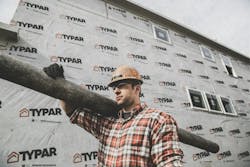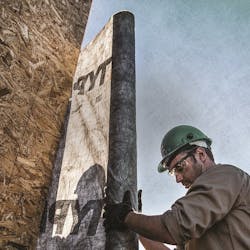Key Considerations to Keep in Mind When Choosing a High-Performance Building Wrap
The use and proper installation of building wraps (also known as weather resistant barriers, housewrap or WRBs’) is no doubt a best practice in builders’ efforts toward managing moisture and air infiltration within exterior walls. To this point, the IRC has outlined guidelines on housewrap installation in section R703 – Exterior Covering of the 2018 IRC. Section R703.1.1 states, “The exterior wall envelope shall be designed and
constructed in a manner that prevents the accumulation of water within the wall assembly by providing a water-resistant barrier behind the exterior cladding … and a means of draining to the exterior water that penetrates the exterior cladding.”
However, there is a wide range of materials and technologies builders can choose when it comes to building wraps. So, how do you know which one performs the best? Before selecting one material over another, ask these five questions to make sure you’re selecting the highest performing housewrap.
Is the Housewrap Durable?
It’s an obvious question, but an important one. A durable housewrap is one that stays in place, has exceptional tear strength, and can stand up to surfactants and UV rays.
Avoid common jobsite do-overs by opting for a high-performance material that has exceptional tear resistance and is designed to withstand heavy winds and jobsite rigors. Additionally, housewraps with superior surfactant resistance will minimize water penetration and the resulting component degradation. Finally, it is best to work with a high-performance material that incorporates UV inhibitors into its coating and fibers, preventing deterioration that can occur from UV exposure. For example, TYPAR® Building Wrap™ provides protection from UV rays for up to six months.
Does the Housewrap Breathe?
A building wrap must breathe to prevent moisture vapor from getting trapped in the wall cavity. Builders should work with high-tech housewraps like those provided by TYPAR® that can balance water holdout with an optimal perm rating of 10 to 20 perms. This perm rating ensures that while water is prevented from entering the wall cavity, ideal levels of moisture vapor are allowed to escape.
Can the Housewrap Serve as an Air Barrier?
It should. It is not too lofty a goal to expect a housewrap to perform as an air barrier that helps reduce air infiltration. High-performance housewraps serve as effective air barriers by reducing convective wind washing against sheathings and air infiltration into stud wall cavities. When installed as part of an air barrier assembly, a housewrap has the ability to reduce drafts in homes, increase indoor comfort, and decrease energy use by reducing the amount of non-conditioned air that enters and exits conditioned wall cavities.
Does the Housewrap Include a System Warranty?
A good warranty speaks volumes about the quality of a product. Some high-performance housewraps on the market back builders with excellent warranties on labor and materials. Be sure to choose a housewrap that offers one.
Is the Housewrap Part of a Holistic System?
Housewraps do not operate in a vacuum. They are part of a holistic approach to airtight construction, or at least that they should be. As such, they require thorough, comprehensive integration with other elements of the building envelope in order to retain system integrity. In other words, be sure to use a system like the TYPAR® Weather Protection System that includes compatible tapes for seaming and adhesive flashings for openings as these details vastly improve the air and moisture resistance of the housewrap.

